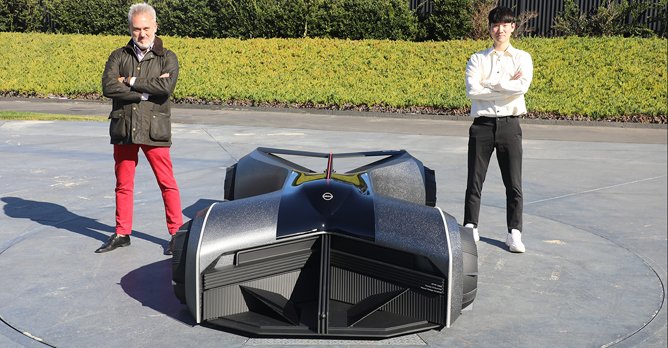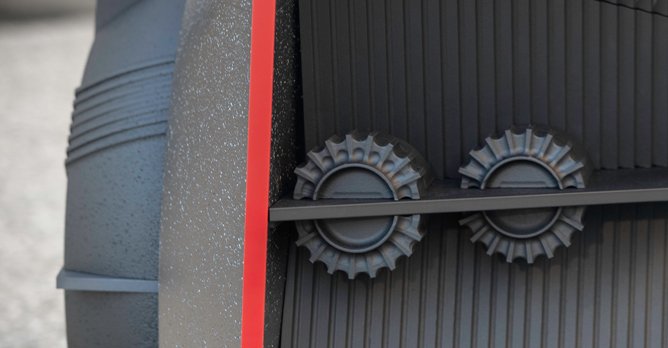Nissan Design creates the GT-R (X) 2050, bringing an intern's dream to life
21 Dec 2020|3,154 views
In 1970, the term 'minivan' had yet to be coined, SUVs were primarily used by outdoor surveyors, and a new kind of supercar emerged wearing the unfamiliar 'GT-R' badging in Japan. And future car designer Jaebum Choi was still decades away from being born in Seoul, South Korea. A lot can change in 50 years.
Choi, like many of the graduating seniors at ArtCenter College of Design in Pasadena, California, looked to the future, the year 2050, for his final thesis. He selected a vehicle with a rebel soul - the Nissan GT-R - for a design study in a future autonomous era when machines can embody a driver's emotion through a physical connection.

"I started my internship at NDA in January and participated in company projects for about two months. Then, I started my 'vision humanoid' project for the rest of the internship, working from home because of COVID-19," said Choi. "Little did I imagine then that the team at NDA would take me under their wings and help me create it as a full-size model."
The completed project runs just under 3,000mm long and sits just over 600mm high. The single occupant, the driver, rests horizontally in a 'prone' position with limbs extended in an X-shape. The driver wears a futuristic form-fitting suit and helmet that resembles a superbike riders' protective helmets and leathers.
As a 'wearable machine,' Choi envisions that connecting the human brain to the computer's would provide better performance than 'ordinary' self-driving cars. He says the vehicle imitates the shape of the human body so it can efficiently protect the brain.
Choi's futuristic project still takes cues from the current Nissan GT-R - namely its bold, dramatic surfaces, monolithic body volumes and V-motion design features. It also has iconic GT-R taillights and red-striped accents of the GT-R NISMO.
Another unique element is the GT-R styled helmet and 'docking' suit. The helmet was designed to be inserted into a slot for front vision camera shared with VR vision. A brain-to-core transmitter would help the human brain activate digitalised signals.
As a vehicle that would be 'driven', most likely at night, manoeuvrability would be a critical part of its high-power electric performance. Choi imagines the vehicle's one-piece wheel and tyre units as having a shape close to square, allowing the vehicle to turn 360 degrees.
The outer tire diameter measures 21 inches and inner wheel circle is 15 inches. The wheels' spoke pattern was designed to help the wheel cool down fast, even under extreme braking. The GT-R (X) 2050 also deploys an active wing that would add downforce when extended. The wing folds so the driver can enter and exit the car.
In 1970, the term 'minivan' had yet to be coined, SUVs were primarily used by outdoor surveyors, and a new kind of supercar emerged wearing the unfamiliar 'GT-R' badging in Japan. And future car designer Jaebum Choi was still decades away from being born in Seoul, South Korea. A lot can change in 50 years.
Choi, like many of the graduating seniors at ArtCenter College of Design in Pasadena, California, looked to the future, the year 2050, for his final thesis. He selected a vehicle with a rebel soul - the Nissan GT-R - for a design study in a future autonomous era when machines can embody a driver's emotion through a physical connection.

"I started my internship at NDA in January and participated in company projects for about two months. Then, I started my 'vision humanoid' project for the rest of the internship, working from home because of COVID-19," said Choi. "Little did I imagine then that the team at NDA would take me under their wings and help me create it as a full-size model."
The completed project runs just under 3,000mm long and sits just over 600mm high. The single occupant, the driver, rests horizontally in a 'prone' position with limbs extended in an X-shape. The driver wears a futuristic form-fitting suit and helmet that resembles a superbike riders' protective helmets and leathers.
As a 'wearable machine,' Choi envisions that connecting the human brain to the computer's would provide better performance than 'ordinary' self-driving cars. He says the vehicle imitates the shape of the human body so it can efficiently protect the brain.
Choi's futuristic project still takes cues from the current Nissan GT-R - namely its bold, dramatic surfaces, monolithic body volumes and V-motion design features. It also has iconic GT-R taillights and red-striped accents of the GT-R NISMO.
Another unique element is the GT-R styled helmet and 'docking' suit. The helmet was designed to be inserted into a slot for front vision camera shared with VR vision. A brain-to-core transmitter would help the human brain activate digitalised signals.
As a vehicle that would be 'driven', most likely at night, manoeuvrability would be a critical part of its high-power electric performance. Choi imagines the vehicle's one-piece wheel and tyre units as having a shape close to square, allowing the vehicle to turn 360 degrees.
The outer tire diameter measures 21 inches and inner wheel circle is 15 inches. The wheels' spoke pattern was designed to help the wheel cool down fast, even under extreme braking. The GT-R (X) 2050 also deploys an active wing that would add downforce when extended. The wing folds so the driver can enter and exit the car.
Latest COE Prices
November 2025 | 1st BIDDING
NEXT TENDER: 19 Nov 2025
CAT A$110,002
CAT B$115,001
CAT C$76,000
CAT E$121,010
View Full Results Thank You For Your Subscription.
























